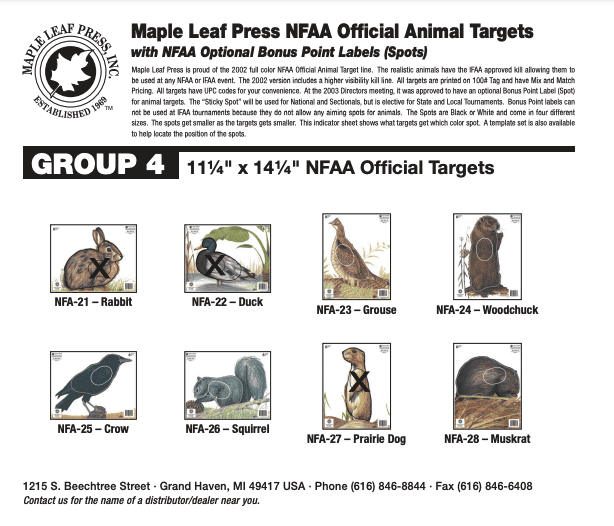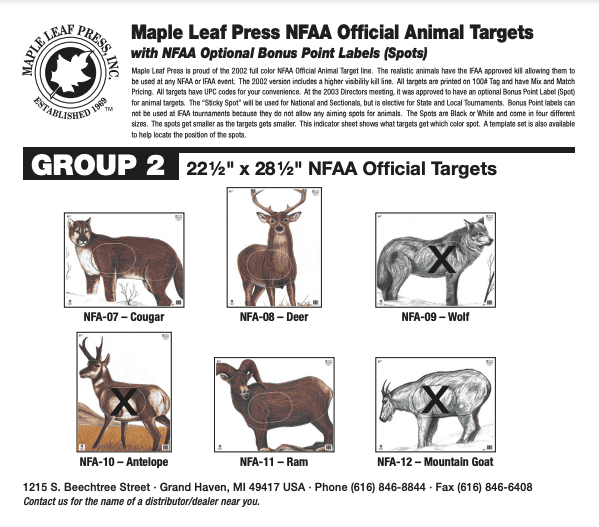This article will dive into Field Archery Basics and walk you through what you can expect at your first Local Field Archery Event. When you finish reading, you’ll be ready to step up to the shooting line and put your first arrow on target.
One could argue that Field is the most challenging form of Archery, demanding a blend of precision and adaptability. Field Archers must contend with various types of terrain, shooting upwards of 112 arrows at targets uphill, downhill, and at odd angles. Target distances can be as far as 80 yards with wind conditions that can easily push an arrow off its mark.
While Field Archery may seem a little daunting, it is loads of fun and is my favorite style of archery. In this article, we will be looking at shooting Field Archery at the club level. If you want to shoot a sanctioned tournament, we recommend joining the NFAA or a Field Archery Association in your State.
Field Archery is a style of archery that is shot outdoors, often in a wooded setting. Courses are made up of 28 Targets split into 14 Target Units. Target sizes are associated with pre-determined distances for Field, Hunter, and Animal Rounds. Field Archery is particularly challenging because terrain and elevation changes can vary significantly from target to target.

Table of Contents
Field Archery Basics: Finding a Local Club
Over the past 30 years, Field Archery has seen a rapid decline in popularity. In many Archery Clubs across the country, Field Archery Courses have been replaced with 3D Archery Courses. While events are few and far between in many states, it is a tremendously fun style of archery.
Finding a Field Archery Club can be a little tricky. The best course of action is to visit the NFAA (National Field Archery Association) Club Finder. Perform a search using Club and Outdoor Field Archery, using your State to narrow the results. This search will return current NFAA-Sanctioned / Affiliated Clubs, and results may be limited.
For additional results, perform a Google Maps Search for Field Archery in your area. This process can be tedious as you’ll need to contact clubs individually to determine if they maintain a Field Archery Course or host Field Archery Events.

Field Archery Basics: Getting Registered
When you locate a Field Archery Event you would like to attend, you will want to contact the host club about registration. Unlike a weekend 3D Archery Shoot, Field Archery Events generally use a Shotgun Start, where archers are assigned a target and begin shooting simultaneously. This limits the number of archers participating at a given start time. The only way to ensure your space is to get registered early.
Most clubs follow the NFAA Equipment Classes for registration.
Field Archery Basics: Organizations
NFAA
The NFAA (National Field Archery Association) is the primary organization in the United States for Field Archery. It was founded in 1939 and comprises 49 State Charters, over one thousand affiliated clubs, and thousands of members worldwide. The NFAA is the governing body for Local, Regional, State, and National Sanctioned Tournaments and is one of the largest Field Archery Organizations.
State Organizations
Depending on the popularity of Archery in your state, there may be a (Non-NFAA) Field Archery Association in your State. These organizations will maintain their own membership and promote events across the state. As an example, here in Pennsylvania, we have two state organizations. We have the PSAA (Pennsylvania State Archery Association) and PFATA (Pennsylvania Fiend and Target Archers Association) – both of which host Field Archery Events across the state.
We encourage you to join your state archery association. Every new membership helps to support the organization and promote archery in your state.
Field Archery Basics: Format
Field Round
The Field Round is two laps around a 14-unit course for 28 targets in total. It uses even distances that range from 20 feet to 80 yards. Each target requires four shots on a Field Face – a white target with black rings. The size of the target is determined by the distance being shot and ranges from 20 to 65 centimeters.
Targets are scored as 5 Points for the black center circle, 4 for the white inner rings, and 3 for the outer black rings. The center X remains 5 points and is used to break tie scores.
Target Distances
The following chart outlines the target distances for an NFAA Field Round. These distances are in no particular order and will vary from one course to the next.
| Type | Distance 1 | Distance 2 | Distance 3 | Distance 4 | Target |
|---|---|---|---|---|---|
| Single | 15 Yards | 15 Yards | 15 Yards | 15 Yards | 35 cm |
| Single | 20 Yards | 20 Yards | 20 Yards | 20 Yards | 35 cm |
| Single | 25 Yards | 25 Yards | 25 Yards | 25 Yards | 35 cm |
| Single | 30 Yards | 30 Yards | 30 Yards | 30 Yards | 35 cm |
| Single | 40 Yards | 40 Yards | 40 Yards | 40 Yards | 50 cm |
| Single | 45 Yards | 45 Yards | 45 Yards | 45 Yards | 50 cm |
| Single | 50 Yards | 50 Yards | 50 Yards | 50 Yards | 50 cm |
| Single | 55 Yards | 55 Yards | 55 Yards | 55 Yards | 65 cm |
| Single | 60 Yards | 60 Yards | 60 Yards | 60 Yards | 65 cm |
| Single | 65 Yards | 65 Yards | 65 Yards | 65 Yards | 65 cm |
| Fan | 35 Yards | 35 Yards | 35 Yards | 35 Yards | 50 cm |
| Walk-Up | 35 Feet | 30 Feet | 25 Feet | 20 Feet | 20 cm |
| Walk-Up | 45 Yards | 40 Yards | 35 Yards | 30 Yards | 50 cm |
| Walk-Up | 80 Yards | 70 Yards | 60 Yards | 50 Yards | 65 cm |
Hunter Round
The Hunter Round is two laps around a 14-unit course for 28 targets in total. It uses odd distances that range from 11 to 70 yards. Each target requires four shots on a Hunter Face – a black target with a white center ring. The size of the target is determined by the distance being shot and ranges from 20 to 65 centimeters.
Targets are scored as 5 Points for the white center circle, 4 for the inner black ring, and 3 for the outer black ring. The center X remains 5 points and is used to break tie scores.
Target Distances
The following chart outlines the target distances for an NFAA Hunter Round. These distances are in no particular order and will vary from one course to the next.
| Type | Distance 1 | Distance 2 | Distance 3 | Distance 4 | Target |
|---|---|---|---|---|---|
| Single | 11 Yards | 11 Yards | 11 Yards | 11 Yards | 20 cm |
| Single | 40 Yards | 40 Yards | 40 Yards | 40 Yards | 50 cm |
| Single | 44 Yards | 44 Yards | 44 Yards | 44 Yards | 50 cm |
| Single | 48 Yards | 48 Yards | 48 Yards | 48 Yards | 50 cm |
| Walk-Up | 53 Yards | 48 Yards | 44 Yards | 41 Yards | 50 cm |
| Walk-Up | 58 Yards | 53 Yards | 48 Yards | 45 Yards | 65 cm |
| Walk-Up | 64 Yards | 59 Yards | 55 Yards | 52 Yards | 65 cm |
| Walk-Up | 70 Yards | 65 Yards | 61 Yards | 58 Yards | 65 cm |
| Walk-Up | 23 Yards | 23 Yards | 20 Yards | 20 Yards | 35 cm |
| Walk-Up | 19 Yards | 19 Yards | 17 Yards | 17 Yards | 35 cm |
| Walk-Up | 15 Yards | 15 Yards | 14 Yards | 14 Yards | 35 cm |
| Fan | 36 Yards | 36 Yards | 36 Yards | 36 Yards | 50 cm |
| Fan | 28 Yards | 28 Yards | 28 Yards | 28 Yards | 35 cm |
| Fan | 32 Yards | 32 Yards | 32 Yards | 32 Yards | 35 cm |
Animal Round
The NFAA Animal Round can be a bit complicated and requires numbered arrows. It comprises a 14-unit course that is scored with the best arrow on the target. You have the opportunity to shoot three arrows, each one scoring differently. Each target contains two scoring zones – a Vital Zone and a Non-Vital Zone. An arrow on the fur or outside of the target scores 0 points.
| Arrow | Vital Score | Non-Vital Score |
|---|---|---|
| 1st Arrow | 20 Point | 18 Points |
| 2nd Arrow | 16 Points | 14 Points |
| 3rd Arrow | 12 Points | 10 Points |
Target Distances
The following chart outlines the target distances for an NFAA Animal Round. These distances are in no particular order and will vary from one course to the next. See the NFAA Official Animal Targets from Maple Leaf Press for a complete list of Animals and Groups.




| Type | Animal | Max Distance | Min Distance | Interval |
|---|---|---|---|---|
| Walk-Up | Group 1 | 60 Yards | 40 Yards | 3 to 5 Yards |
| Walk-Up | Group 1 | 60 Yards | 40 Yards | 3 to 5 Yards |
| Walk-Up | Group 1 | 60 Yards | 40 Yards | 3 to 5 Yards |
| Walk-Up | Group 2 | 45 Yards | 30 Yards | 3 to 5 Yards |
| Walk-Up | Group 2 | 45 Yards | 30 Yards | 3 to 5 Yards |
| Walk-Up | Group 2 | 45 Yards | 30 Yards | 3 to 5 Yards |
| Single | Group 3 | 35 Yards | 20 Yards | |
| Single | Group 3 | 35 Yards | 20 Yards | |
| Single | Group 3 | 35 Yards | 20 Yards | |
| Single | Group 3 | 35 Yards | 20 Yards | |
| Single | Group 4 | 20 Yards | 10 Yards | |
| Single | Group 4 | 20 Yards | 10 Yards | |
| Single | Group 4 | 20 Yards | 10 Yards | |
| Single | Group 4 | 20 Yards | 10 Yards |
Field Archery Basics: Get Out and Shoot
Now, you should have a firm grasp on Field Archery Basics and be ready to get out and shoot your first Local Field Archery Event. We want to encourage you to get out there and try Field Archery. Don’t forget to drop us a line at ArcheryCompass@Gmail.Com and let us know how it went!
More on Field Archery
Does Field Archery sound like something you’d like to learn more about? At Archery Compass, we aim to be a resource for the Archery Community. Below is a breakdown of our recent Field Archery Blog Posts. Be sure to check them out and share them with your friends!
